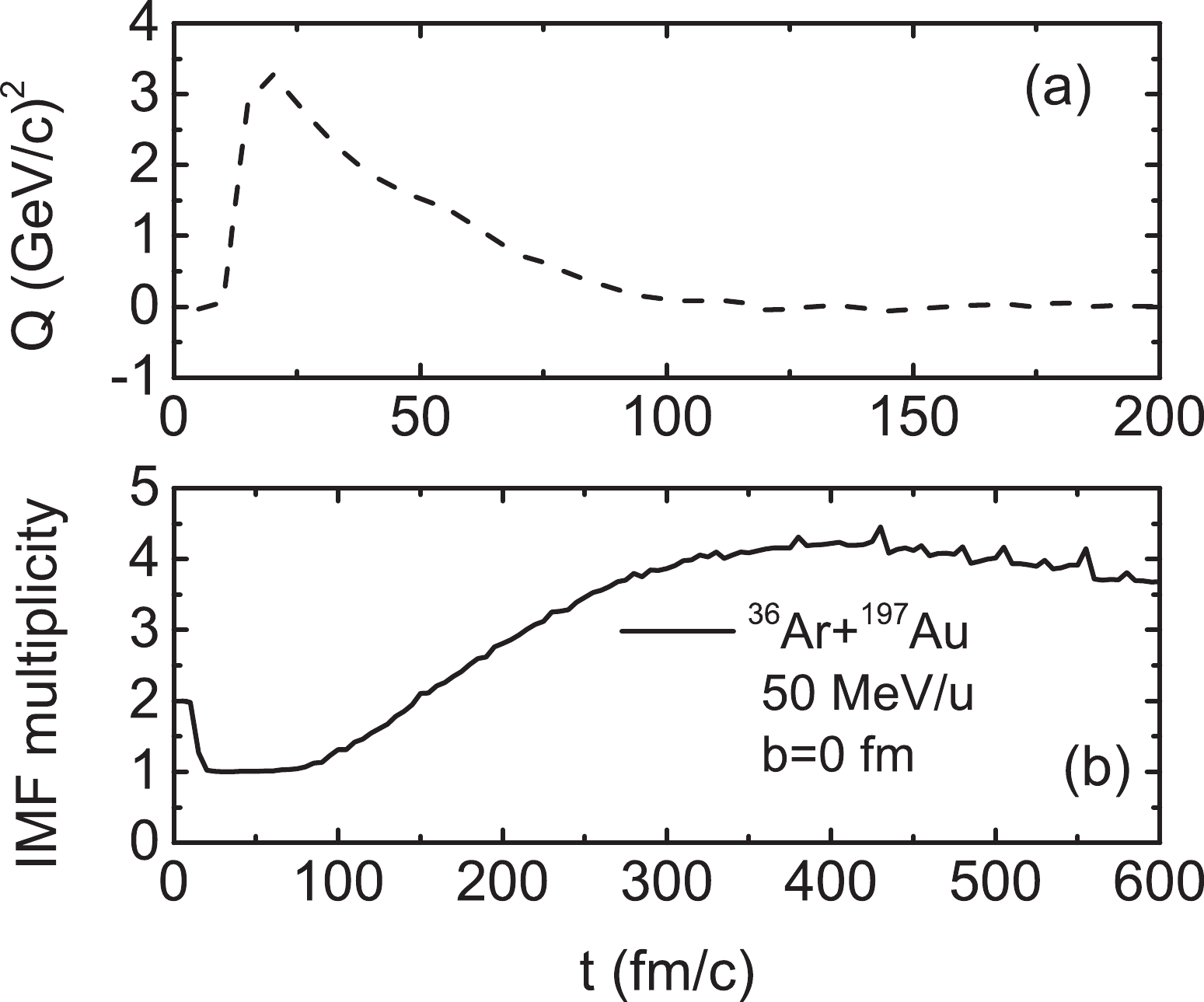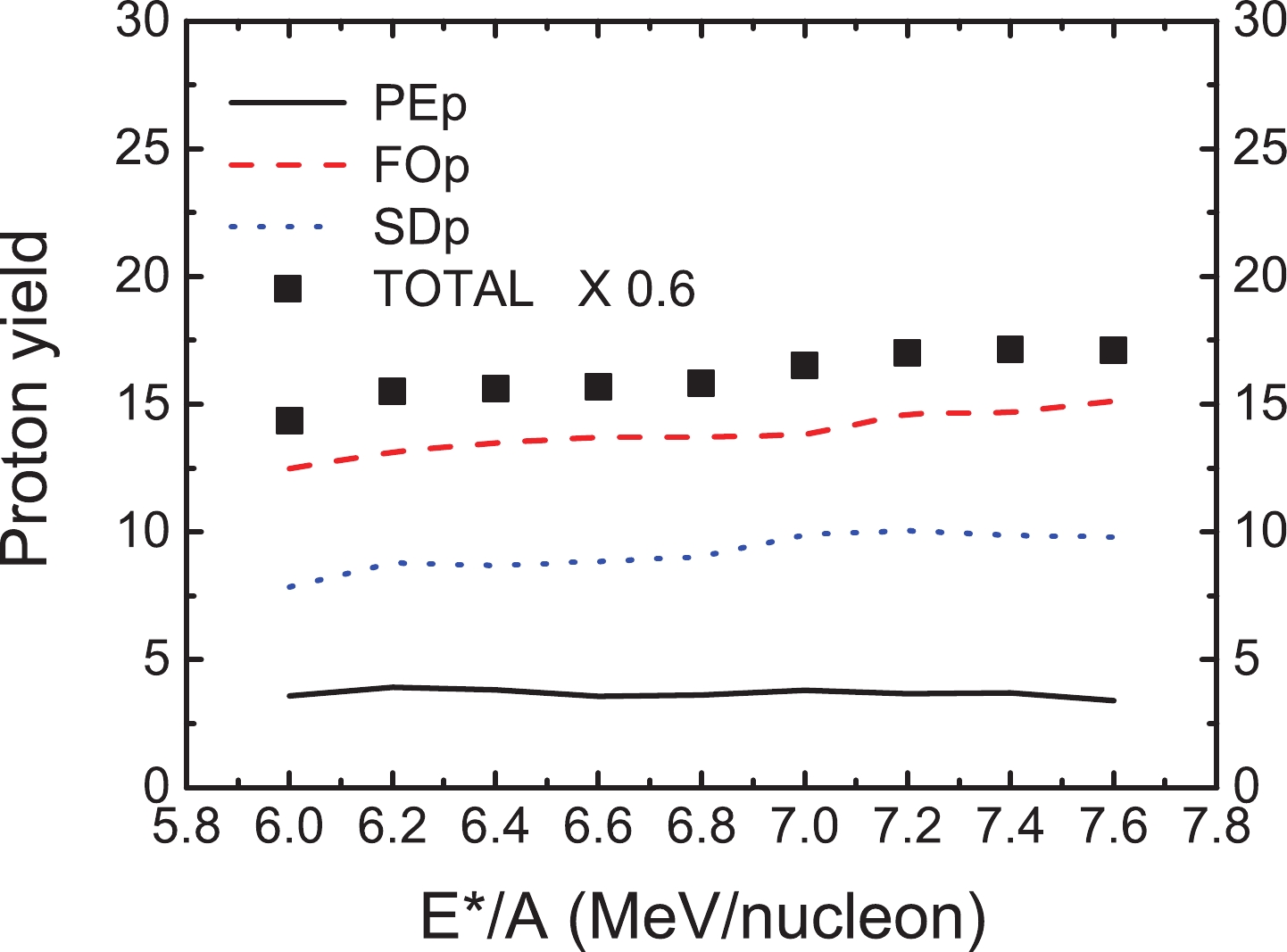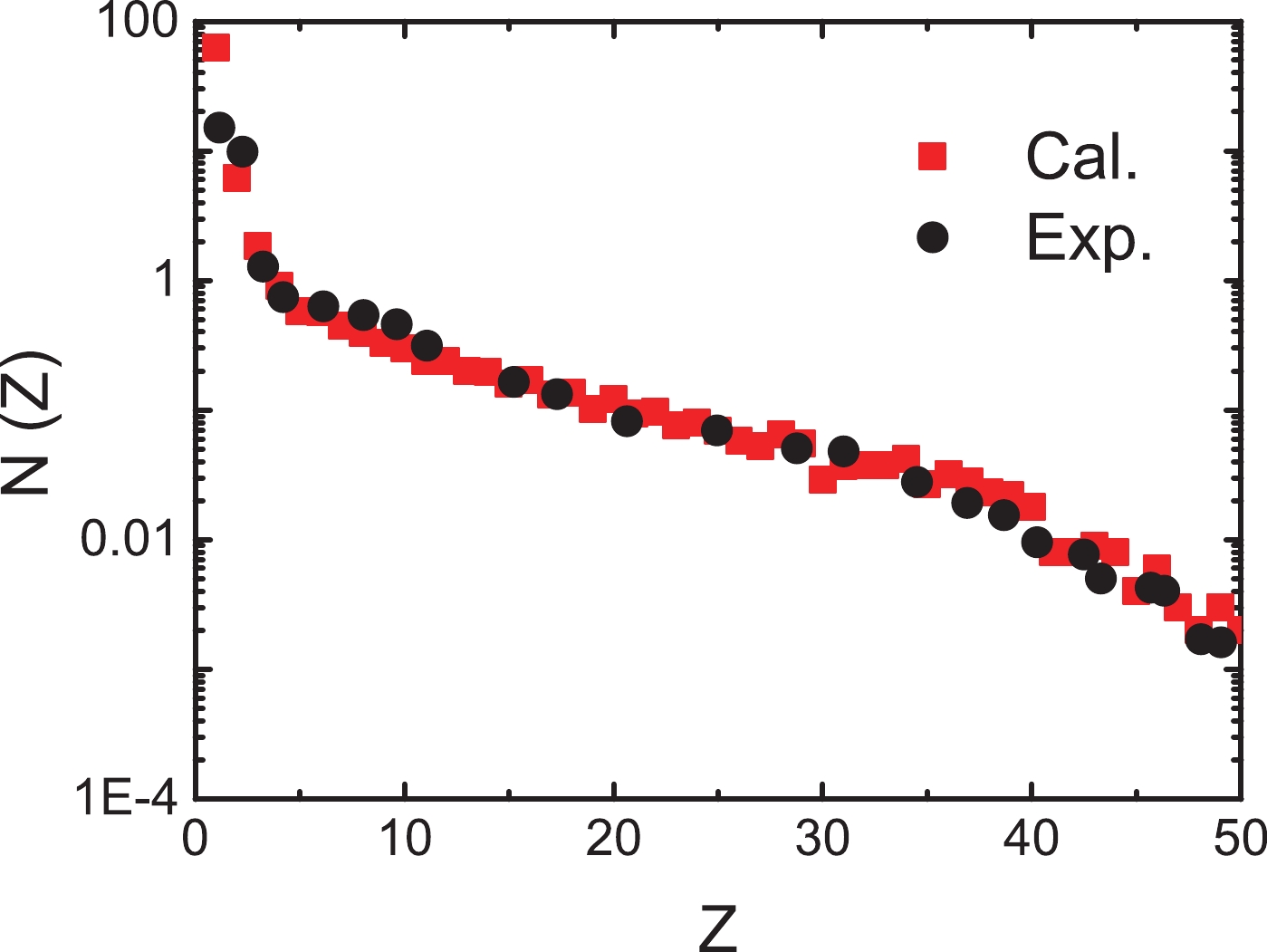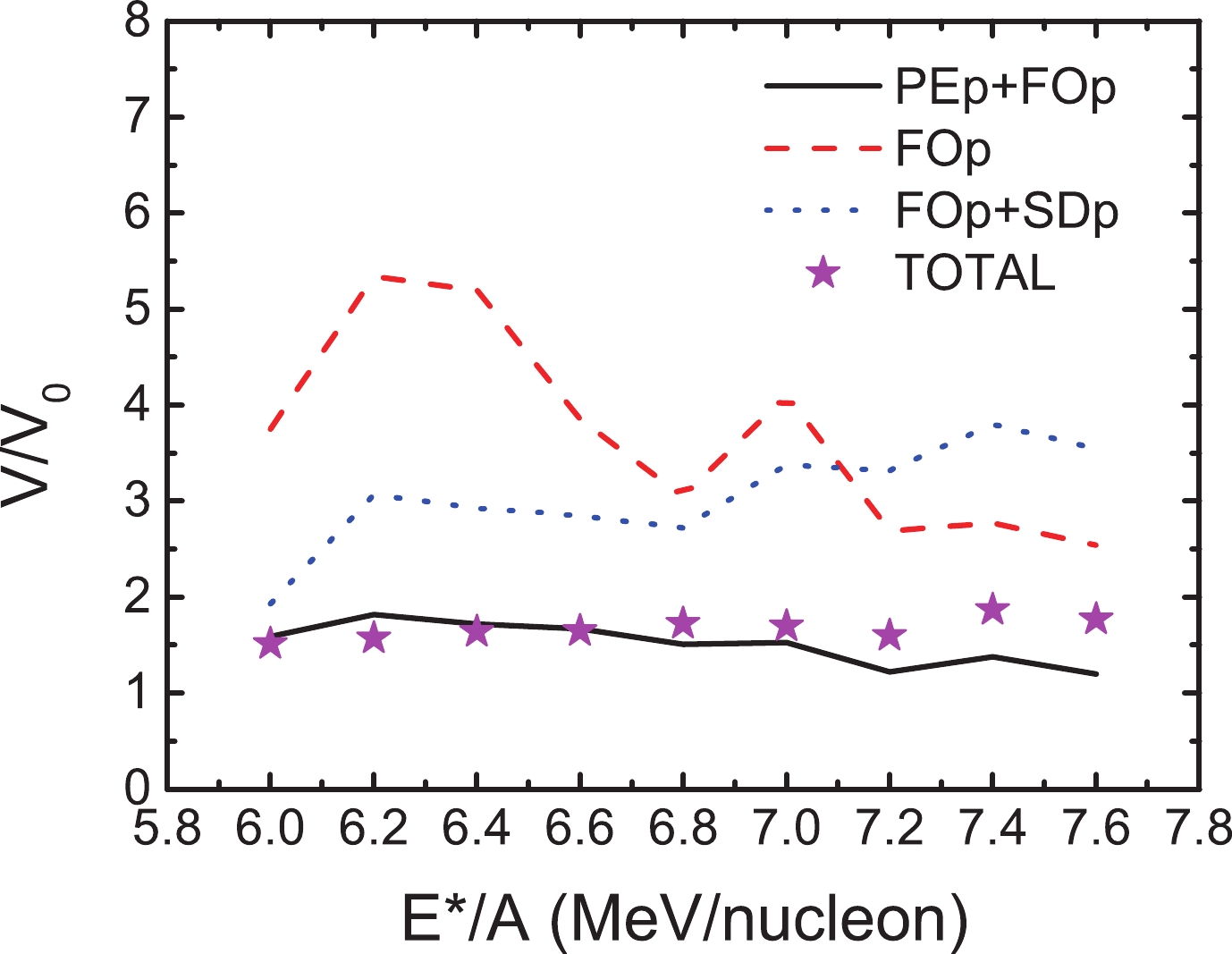HTML
--> --> -->Heavy-ion collisions are the only means of studying the properties of hot nuclei [17]. In such collisions, the dynamical process can be divided into three stages. (i) The system driven by intensive interactions between nucleons evolves toward thermalization, and fast particles leave the system. The time interval of this stage is approximately several tens of fm/c. The particle emission of this stage is pre-equilibrium emission. (ii) The hot nuclear residue expands and breaks up into hot primary fragments. The produced fragments are in the freeze-out stage. (iii) The primary fragments are de-excited by emitting particles and gamma rays to the final ground states.
In the present work, the focus is on the freeze-out volume. Experimental studies are extremely valuable for determining the freeze-out volume. The extraction of the volume from the measured yields of particles is discussed, and the temperature and density are studied using the yields and quantum fluctuations of light charged particles (Z
$ \phi_{i}({{\mathit{\boldsymbol{r}}}}_{i},t) = \frac{1}{(2\pi L)^{3/4}}{\rm e}^{\textstyle-\frac{[{{\mathit{\boldsymbol{r}}}}_{i}-{{\mathit{\boldsymbol{r}}}}_{i0}(t)]^{2}} {4L}}{\rm e}^{\textstyle{\rm i}\frac{{{\mathit{\boldsymbol{r}}}}_{i}\cdot {{\mathit{\boldsymbol{p}}}}_{i0}(t)}{\hbar}}, $  | (1) |
$ f({{\mathit{\boldsymbol{r}}}},{{\mathit{\boldsymbol{p}}}},t) = \sum\limits_{i = 1}^{n}\frac{1}{(\pi\hbar)^{3}} {\rm e}^{\textstyle-\frac{[{{\mathit{\boldsymbol{r}}}}-{{\mathit{\boldsymbol{r}}}}_{i0}(t)]^{2}} {2L}}{\rm e}^{\textstyle-\frac{[{{\mathit{\boldsymbol{p}}}}-{{\mathit{\boldsymbol{p}}}}_{i0}(t)]^{2}\cdot 2L}{\hbar^{2}}}. $  | (2) |
$ \dot{{{\mathit{\boldsymbol{r}}}}}_{i0} = \nabla_{{{\mathit{\boldsymbol{p}}}}_{i0}}H, \dot{{{\mathit{\boldsymbol{p}}}}}_{i0} = -\nabla_{{{\mathit{\boldsymbol{r}}}}_{i0}}H, $  | (3) |
$ H = E_{\rm kin}+U_{\rm Coul}+\int V(\rho){\rm d}r. $  | (4) |
$ V_{\rm sky} = \frac{\alpha}{2}\frac{\rho^{2}}{\rho_{0}} +\frac{\beta}{\gamma+1}\frac{\rho^{\gamma+1}}{\rho_{0}^{\gamma}}, $  | (5) |
$ V_{\rm sur} = \frac{g_{\rm sur}}{2}\frac{(\nabla\rho)^{2}}{\rho_{0}} +\frac{g_{\rm sur}^{\rm iso}}{2}\frac{(\nabla\rho_{n}-\nabla\rho_{p})^{2}}{\rho_{0}}, $  | (6) |
$ V_{\rm mdi} = g_{\tau}\frac{\rho^{8/3}}{\rho^{5/3}_{0}}. $  | (7) |
$ V_{\rm sym} = \frac{C_{\rm sym}}{2}\frac{(\rho_{n}-\rho_{p})^{2}} {\rho_{0}}. $  | (8) |
In this study, the dynamical description is used not only for the excitation stage but also for intermediate-mass-fragment (IMF) emission. Following the excitation stage, the time evolution in the IQMD code continues until the excitation energy of the heaviest hot fragment decreases to a certain value
To study the freeze-out volume, the central collisions of small-mass projectiles and large-mass targets are used to produce hot nuclei. For such reaction systems, sufficient nucleons exist in the overlap volume to experience the required collisions for hot-nuclei thermalization [24]. To reduce the effects of the mass range of the hot nuclei on the proton production, the narrow mass number range of the hot nuclei is required to be 190
Using the hot nuclei, the freeze-out temperatures can be calculated by the isotope-yield-ratio method of Albergo
$ T_{\rm BeLi} = 11.3\;{\rm{MeV}}/ {\ln}\left(1.8\frac{Y_{^{9}\rm Be}/Y_{^{8}\rm Li}} {Y_{^{7}\rm Be}/Y_{^{6}\rm Li}}\right). $  | (9) |
At the freeze-out stage, protons (p), neutrons (n), tritium, etc., follow Fermi statistics, whereas deuterium,
$ \rho_{Fp} = \frac{4\pi(2m)^{3/2}}{h^{3}}\int_{0}^{\infty} \frac{ \varepsilon^{1/2}{\rm d}\varepsilon}{{\rm e}^{\textstyle\frac{\varepsilon-\mu}{T}}+1}, $  | (10) |
The multiplicity for a proton can be expressed as
$ N = \frac{4\pi V (2m)^{3/2}}{h^{3}}\int_{0}^{\infty} \frac{ \varepsilon^{1/2}{\rm d}\varepsilon}{{\rm e}^{\textstyle\frac{\varepsilon-\mu}{T}}+1}, $  | (11) |
$ \langle(\Delta N)^{2}\rangle = T\bigg(\frac{\partial N}{\partial \mu} \bigg)_{T,V}. $  | (12) |
$ \langle (\Delta N)^{2} \rangle = \frac{4\pi V (2m)^{3/2}}{h^{3}}\int_{0}^{\infty} \frac{{\rm e}^{\textstyle\frac{\varepsilon-\mu}{T}}\varepsilon^{\textstyle\frac{1}{2}} {\rm d}\varepsilon} {\left({\rm e}^{\textstyle\frac{\varepsilon-\mu}{T}}+1\right)^{2}}. $  | (13) |
$ \frac{\langle(\triangle N)^{2}\rangle}{N} = \frac{\displaystyle\int_{0}^{\infty}\varepsilon^{\textstyle\frac{1}{2}}{\rm d}\varepsilon \dfrac{{\rm e}^{\textstyle\frac{\varepsilon-\mu}{T}}}{\left({\rm e}^{\textstyle\frac{\varepsilon-\mu}{T}}+1\right)^{2}}} {\displaystyle\int_{0}^{\infty}\varepsilon^{\textstyle\frac{1}{2}}{\rm d}\varepsilon \dfrac{1}{{\rm e}^{\textstyle\frac{\varepsilon-\mu}{T}}+1}}. $  | (14) |
 Figure1. (a) Time evolution of quadrupole momentum for maximum mass cluster and (b) IMF multiplicity for reaction system.
Figure1. (a) Time evolution of quadrupole momentum for maximum mass cluster and (b) IMF multiplicity for reaction system. $ Q_{p} = \int(2p_{z}^{2}-p_{x}^{2}-p_{y}^{2}) f({{\mathit{\boldsymbol{r}}}},{{\mathit{\boldsymbol{p}}}},t){\rm d}{{\mathit{\boldsymbol{r}}}}{\rm d}{{\mathit{\boldsymbol{p}}}}. $  | (15) |
It can be observed from Fig. 1(a) that the quadrupole increases rapidly at 10 fm/c. At this moment, the projectile and target are in contact with one another. At approximately 80 fm/c, the quadrupole recovers to zero again. The momentum of nucleons reaches an isotropic distribution at 100 fm/c [24]. Thus, the protons emitted before 100 fm/c comprise pre-equilibrium emission. With the change in the reaction time, the hot nuclei expand and break into primary fragments. The hot nuclei reach the freeze-out stage, and the freeze-out moment can be estimated from the time evolution of the multiplicity of IMFs. It can be observed that the multiplicity of IMFs ends its variation at approximately 400 fm/c. The protons produced after 400 fm/c constitute secondary decay. Therefore, in this study, the protons are divided into four parts: (i) pre-equilibrium emission (PEp), (ii) protons produced in the freeze-out stage (FOp), (iii) secondary decay (SDp), and (iv) PEp+FOp+SDp (TOTAL).
In the following discussion, the focus is on the moderate excitation energy range (6-8 MeV/nucleon). To produce moderate excitation hot nuclei, three beam energies are selected, namely 50, 60, and 70 MeV/u. The reaction system is
 Figure2. (color online) Proton yield at different stages (PEp, FOp, SDp, and TOTAL) as a function of excitation energy.
Figure2. (color online) Proton yield at different stages (PEp, FOp, SDp, and TOTAL) as a function of excitation energy.In heavy-ion collisions, the hot nuclei will be de-excited by disintegration. The de-excitation process can be light-particle (Z
 Figure3. (color online) Charge distribution N(Z) in central
Figure3. (color online) Charge distribution N(Z) in central The freeze-out temperatures are shown in Fig. 4(a). The calculation points are plotted for 0.2-MeV/nucleon-wide bins in excitation energy per nucleon. The MFp versus excitation energy per nucleon is plotted in Fig. 4(b). The proton yield of the secondary decay is approximately 3 times that of the pre-equilibrium emission (see Fig. 2). However, the normalized fluctuations are more easily affected by the pre-equilibrium emission. The secondary decay process is more complex than the pre-equilibrium emission process. Many de-excitation routes are available for secondary decay, and therefore, the competition among the different de-excitation routes increases the fluctuation of the proton production.
 Figure4. (color online) (a) Freeze-out temperatures and (b) multiplicity fluctuation for proton vs. excitation energy per nucleon
Figure4. (color online) (a) Freeze-out temperatures and (b) multiplicity fluctuation for proton vs. excitation energy per nucleon The freeze-out volume versus excitation energy is plotted in Fig. 5. The freeze-out volume can be calculated by four groups of protons (FOp+PEp, FOp, FOp+SDp, and TOTAL). The freeze-out volume calculated by FOp is approximately 2 times that of FOp+PEp. The freeze-out volumes are almost the same between TOTAL and FOp+ PEp. The difference in the freeze-out volume between FOp and FOp+SDp is smaller than that between FOp and FOp+PEp.
 Figure5. (color online) Freeze-out volume calculated by protons produced at different stages as a function of excitation energy.
Figure5. (color online) Freeze-out volume calculated by protons produced at different stages as a function of excitation energy.The study of the freeze-out volume is helpful for gaining an improved understanding of the multifragmentation process, which may offer the possibility for investigating the nuclear liquid-gas transition. Experimental studies are indespensible to obtain the freeze-out volume and understand the freeze-out concept. However, the particles detected experimentally include the information of pre-equilibrium and secondary decay. The determination of the freeze-out information is affected by the interference of the pre-equilibrium and secondary decay. Therefore, it is necessary to study the effects of pre-equilibrium emission and secondary decay on the determination of the freeze-out information. In this work, the freeze-out volume is studied by the multiplicity fluctuation for a proton. The calculations indicate that pre-equilibrium emission and secondary decay will affect the determination of the freeze-out information. When using the quantum fluctuations of the proton to study the freeze-out volume, the effect of pre-equilibrium emission is more obvious. However, the present results calculated by the IQMD model depend on the model parameters. The use of different model parameters may lead to different results. Therefore, the effects of different model parameters on the determination of the freeze-out volume should be studied in the future.
Owing to the effects of pre-equilibrium emission and secondary decay, the percentage of protons in the freeze-out stage is only approximately 50%. In the de-excitation process, the proton yield produced by secondary decay is approximately 3 times that of pre-equilibrium emission. However, the normalized fluctuations are more easily affected by pre-equilibrium emission because the secondary decay process is more complex. The competition among the different de-excitation routes increases the fluctuation of the proton production. Therefore, when using the multiplicity fluctuation of protons to study the freeze-out volume, more attention should be paid to pre-equilibrium emission.
It should be stressed that the present results are based on specific IQMD model parameters. If different model parameters are used, different results may be obtained. Therefore, these effects should be studied in the future.
